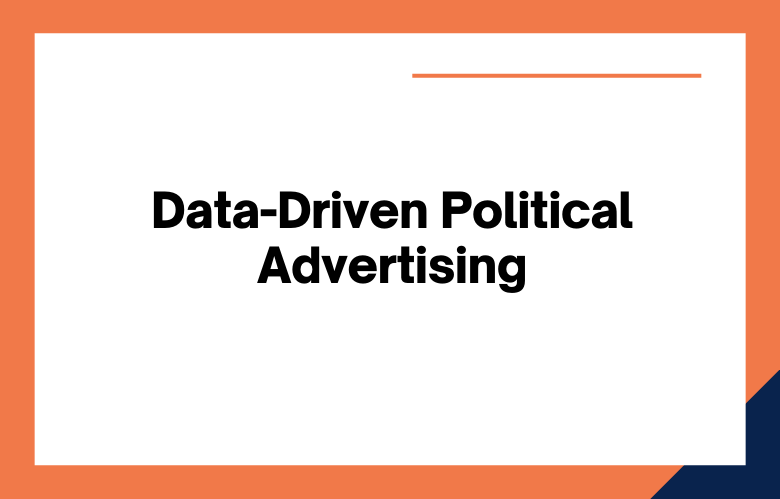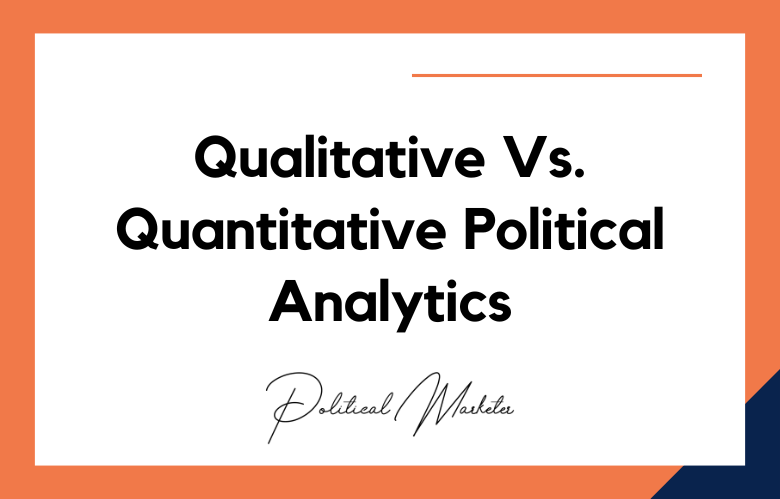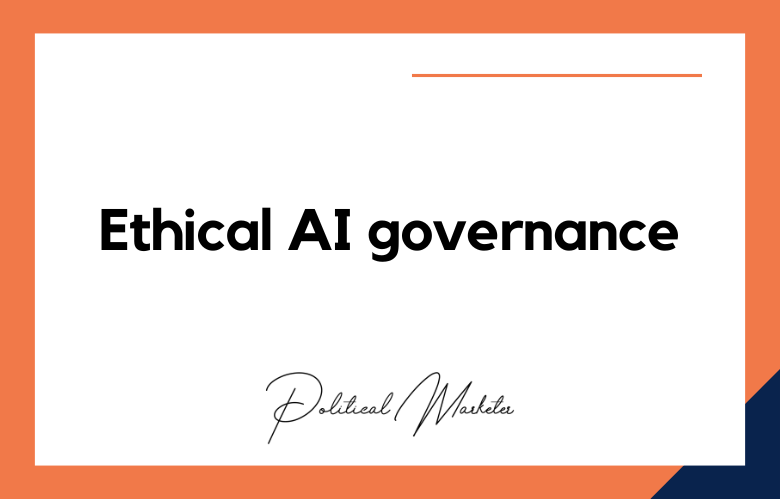Fascinating findings from a recent study by the Pew Research Center show that political advertising is rapidly changing as technology becomes more prevalent. Several implications in these changes for voters, such as how they may no longer rely on traditional media outlets like newspapers and television networks to inform themselves about candidates.
Instead, voters must focus on social media platforms such as Facebook, where most data-driven campaigning occurs. For voters to keep up with the ever-changing world of campaign tactics, it’s more important than ever to learn how political advertising works in today’s digital age.
What is Data-Driven Political Advertising
Data-Driven Political Advertising uses data and analytics to shape campaign strategy. It is believed that political advertisers can employ advanced data analytical tools to identify potential voters, develop specific messages for them, and measure how they respond.
Data-driven political advertising is the use of data to target voters in campaigns for political office. It has been a growing industry since digital media came into widespread usage.
Data-Driven Political Advertising (DDPA) is a form of political advertising where the campaign strategically uses data collection and analysis to focus on voters. By collecting data about their audience, campaigns can deliver more effective messages that are relevant to them.
Data-Driven Political Advertising is the use of data in campaigns to influence voting.
The Importance of Data in Political Campaigns
Data is vital to a politician’s success. It often shows the difference between winning and losing an election.
Data is one of the essential resources for any political campaign. You can’t make informed decisions without it.
One of the most valuable aspects that political campaigns need is data. Data can help strategize, find voters who support a candidate, and engage people with their message.
The data gathered from surveys and polls can help you get the word out about your campaign. It’s essential to keep track of trends within your market to know where you need more support for your platform.
The importance of data in political campaigns is evident. Tracking and analyzing voter information is vital, especially when working on a drive the size of Bernie Sanders’s presidential run.
How does a Campaign collect Data on Voters and Potential Supporters?
Campaigns use many different types of data to help them run their campaigns. They collect this information by asking voters and potential supporters for it through surveys, phone calls, door-to-door contacts, emails, and social media posts.
A campaign can collect data on voters and potential supporters through social media, phone calls, door-to-door knocking, and surveys.
There are many ways to collect data on potential supporters and voters. One way is by visiting their homes, but it’s very time-consuming.
Campaigns use data to target voters and potential supporters. The movement gathers information about voters from voter files and lists of registered voters that the political party or candidate owns. Campaigns also do their surveys via phone calls or door-to-door.
Concerns about the Use of Data-Driven Political Advertising
Millions of dollars in political advertising are spent every year, and this money is typically used to influence voters on social media.
So many concerns about using big data in political advertising and how it might influence people’s decisions.
Why do people use Data-Driven Political Advertising?
Data-driven political advertising is used to reach and persuade potential voters using a targeted approach.
There are many reasons why candidates use data-driven political advertising. One of the main reasons is to ensure they’re appealing to their target audience.
Politicians use data-driven political advertising to gain the support of their constituents by tailoring messages and content to them.
Advertising is essential if you run for political office and want to get elected. The best way to do this is through Data-Driven Political Advertising because it allows you to target the people in your district who will most likely vote.
The Future of Data-Driven Political Advertising
Data-driven political advertisements are an effective tool for influencing citizens.
According to the Pew Research Center, most adults in both parties use Facebook and Twitter. With social media’s growing importance as a primary source of political information, we can expect political advertising to continue targeting users on these platforms.
Politics has always been important to the human race. They’ve also been used as a way for one side to gain power over another. The current political climate is no different, and there are many ways of achieving support from people by influencing their opinions.
Data-Driven Political Advertising is the future of politics. It allows you to target specific demographics with a specifically tailored message for them, increasing your chances of winning elections.
Data-Driven Political Advertising Best Practices
- Start with a clear understanding of the problem you want to solve
- Define your target audience and develop a persona for them
- Use data to test different messages and find what resonates best
- Create variations of ads that will work across channels (web, social media, TV)
- Create a plan for your campaign
- Identify the type of advertising you want to pursue and your target audience.
- Research what channels will be most effective for your messages, such as TV, radio, internet ads, or mailbox flyers.
- Develop an advertising schedule that will allow you to reach your target audience at critical moments in their decision process (i.e., before they vote)
- Determine how much money is available for this effort and decide which tactics make the most sense given those constraints.
- Understand what your target audience wants and cares about
- Speak to the values of your target audience
- Create messages relevant to your target audience, not just “issues” or “politics.”
- Use data-driven targeting to identify likely supporters and create specific ads for them.
- Leverage social media advertising platforms such as Facebook and Twitter
- Develop a data-driven advertising strategy
- Understand the difference between persuasion and conversion ads, which you should target for your political campaign.
- Use retargeting to reach people who have already been on your website or social media pages with ads explicitly tailored to their interests.
- Create variations of your ad content so they don’t get tired of seeing the same thing repeatedly.
- Measure the success of each campaign by looking at things like how many clicks it got, how much time was spent on the page, etc.
- Use your budget wisely to target the right audience
- Ensure that you are using the most up-to-date technology and software
- Research how political advertising has been done in the past to learn from the mistakes of others
- Be creative with your messaging and make sure it is relevant to those you are targeting
Conclusion
Data-driven political advertising is a digital marketing strategy that has been around for years. However, with the rise of social media and advanced technology, data-driven political campaigns are now more powerful than ever before. With this blog post, we hope you’ve learned how to use your customer intelligence to create effective ads that speak directly to them on their terms.
If you want help creating or executing an ad campaign based on data insights, please get in touch with us! We will offer consulting services tailored specifically to your needs, as well as a team that will implement any strategies necessary so that you have everything covered from start to finish. Have any questions? Let me know in the comments below!
Data-Driven Political Advertising: The future of Data-Driven Political Advertising – FAQs
What Is Data-Driven Political Advertising?
Data-driven political advertising refers to the use of voter data and analytics to target specific demographics with tailored campaign messages across various digital platforms.
Why Is Data Important In Political Campaigns?
Data helps campaigns identify voter segments, understand public opinion, predict behavior, and personalize outreach strategies for better engagement and outcomes.
What Types Of Data Are Used In Political Advertising?
Campaigns use first-party data (collected directly), second-party data (from partners), and third-party data (from external vendors) including demographics, interests, behavior, and location.
How Do Political Campaigns Collect Voter Data?
They gather data from sources like voter rolls, website analytics, social media interactions, mobile apps, email signups, and canvassing efforts.
What Are Microtargeting Techniques In Political Ads?
Microtargeting involves delivering highly specific messages to small voter segments based on their data profiles, behaviors, or preferences.
How Does Social Media Play A Role In Data-Driven Campaigns?
Social platforms allow advertisers to target users using behavioral, demographic, and interest-based filters powered by sophisticated ad algorithms.
Can Data Help In Identifying Swing Voters?
Yes, predictive models built on voter data can help identify persuadable or undecided voters, enabling focused campaign efforts.
How Is A/B Testing Used In Political Ads?
Campaigns use A/B testing to compare different versions of ad creatives, messages, or calls to action to see which performs best among targeted audiences.
What Role Does Geolocation Data Play In Political Advertising?
Geolocation allows campaigns to target users based on physical location, tailoring messages for state, district, or even neighborhood-level precision.
What Is The Difference Between Persuasion And Mobilization Campaigns?
Persuasion aims to change opinions or win over undecided voters, while mobilization focuses on encouraging likely supporters to turn out and vote.
How Can Email Campaigns Be Personalized Using Voter Data?
Campaigns segment email lists by location, interests, issue preferences, and past behavior to deliver relevant content that boosts engagement.
Are Lookalike Audiences Used In Political Campaigns?
Yes, platforms like Facebook allow campaigns to create lookalike audiences based on existing supporter data to reach new but similar individuals.
What Is The Role Of CRMs In Managing Voter Data?
Campaign CRMs (Customer Relationship Management systems) organize and centralize voter data, track interactions, and streamline outreach.
How Do Political Campaigns Use Retargeting Ads?
Retargeting allows campaigns to show ads to users who previously visited their websites or interacted with their content but did not convert.
Can Behavioral Data Be Used To Predict Voter Turnout?
Yes, machine learning models use behavioral signals like past voting history, online activity, and demographic data to estimate turnout likelihood.
What Is Cross-Channel Targeting In Political Ads?
It refers to coordinating ad delivery across multiple platforms like social media, email, SMS, and streaming to maintain message consistency.
How Is Data Compliance Handled In Political Advertising?
Campaigns must follow data protection laws and platform policies, especially regarding consent, privacy, and transparency in ad targeting.
Why Is Real-Time Data Monitoring Important During Campaigns?
It enables rapid adjustments to strategy, messaging, and ad spend based on live performance insights, voter reactions, and external events.
What Are The Ethical Concerns In Data-Driven Political Advertising?
Key concerns include data misuse, privacy violations, manipulation through microtargeting, and lack of transparency in how data influences decisions.
How Will AI Impact The Future Of Political Advertising?
AI can automate ad personalization, optimize budgets, generate persuasive content, and enhance targeting precision, but raises regulatory and ethical challenges.
One way to get in touch is by filling out our online form on this site or give us a call at +919848321284. Let’s work together today!











